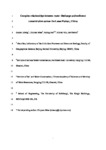Complex relationships between water discharge and sediment concentration across the Loess Plateau, China
| dc.contributor.author | Zheng, H | |
| dc.contributor.author | Miao, C | |
| dc.contributor.author | Jiao, J | |
| dc.contributor.author | Borthwick, Alistair | |
| dc.date.accessioned | 2021-08-22T10:40:05Z | |
| dc.date.available | 2021-08-22T10:40:05Z | |
| dc.date.issued | 2021-05 | |
| dc.identifier.issn | 0022-1694 | |
| dc.identifier.other | 126078 | |
| dc.identifier.uri | http://hdl.handle.net/10026.1/17644 | |
| dc.description.abstract |
Understanding of the relationship between water discharge (Q) and suspended sediment concentration (SSC) across the Loess Plateau is a prerequisite for evaluating different soil and water conservation measures. Using daily Q and SSC datasets, this study jointly analyzes changes in Q and SSC on the central Loess Plateau, a major sediment-producing area of China, during the periods 1971-1987 (P1) and 2008-2016 (P2). The results show that during both P1 and P2, the contributions of maximum-3-day-per-year sediment load (SSL) to the total SSL are almost invariably over 50% (dominant), with the majority increasing further between P1 and P2. The contribution of extreme high SSL events plays an overwhelming role in watersheds of area < 10,000 km2, and appears almost independent of change in land cover condition. In the Helong section of the Yellow River, there is more evident reduction in SSC than Q between these two periods (streamflow becomes clearer), while the opposite occurred in the Jing River (streamflow lowers). In addition, the range of variation in SSC is large for small Q values, whereas the SSC for flood events tends to be relatively stable in gullied-hilly and flat-surfaced (Yuan) loess areas, which are major sediment producers. Based on scatter plots of SSC against Q after logarithmic transformation, we find that the lower boundary of the mapped data points for an individual station fits a straight line. This boundary relates to riverbed erosion. Given that soil erosion weakened on slopes over time and there is generally reduced streamflow in channels during P2, the boundary tends to move downward between P1 and P2 for most watersheds, reflecting the reduction in SSC for the same value of Q in P2 compared to P1. | |
| dc.format.extent | 126078-126078 | |
| dc.language | en | |
| dc.language.iso | en | |
| dc.publisher | Elsevier BV | |
| dc.title | Complex relationships between water discharge and sediment concentration across the Loess Plateau, China | |
| dc.type | journal-article | |
| dc.type | Journal Article | |
| plymouth.volume | 596 | |
| plymouth.publication-status | Published | |
| plymouth.journal | Journal of Hydrology | |
| dc.identifier.doi | 10.1016/j.jhydrol.2021.126078 | |
| plymouth.organisational-group | /Plymouth | |
| plymouth.organisational-group | /Plymouth/Faculty of Science and Engineering | |
| plymouth.organisational-group | /Plymouth/Faculty of Science and Engineering/School of Engineering, Computing and Mathematics | |
| plymouth.organisational-group | /Plymouth/Users by role | |
| plymouth.organisational-group | /Plymouth/Users by role/Academics | |
| dcterms.dateAccepted | 2021-02-05 | |
| dc.rights.embargodate | 2022-2-16 | |
| dc.rights.embargoperiod | Not known | |
| rioxxterms.versionofrecord | 10.1016/j.jhydrol.2021.126078 | |
| rioxxterms.licenseref.uri | http://www.rioxx.net/licenses/all-rights-reserved | |
| rioxxterms.licenseref.startdate | 2021-05 | |
| rioxxterms.type | Journal Article/Review |


